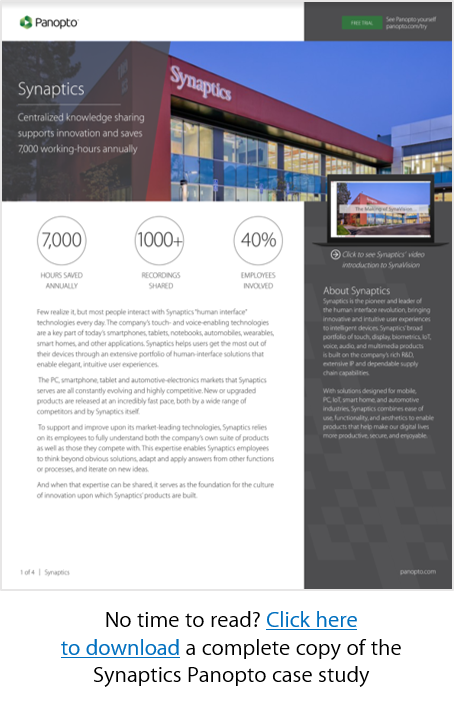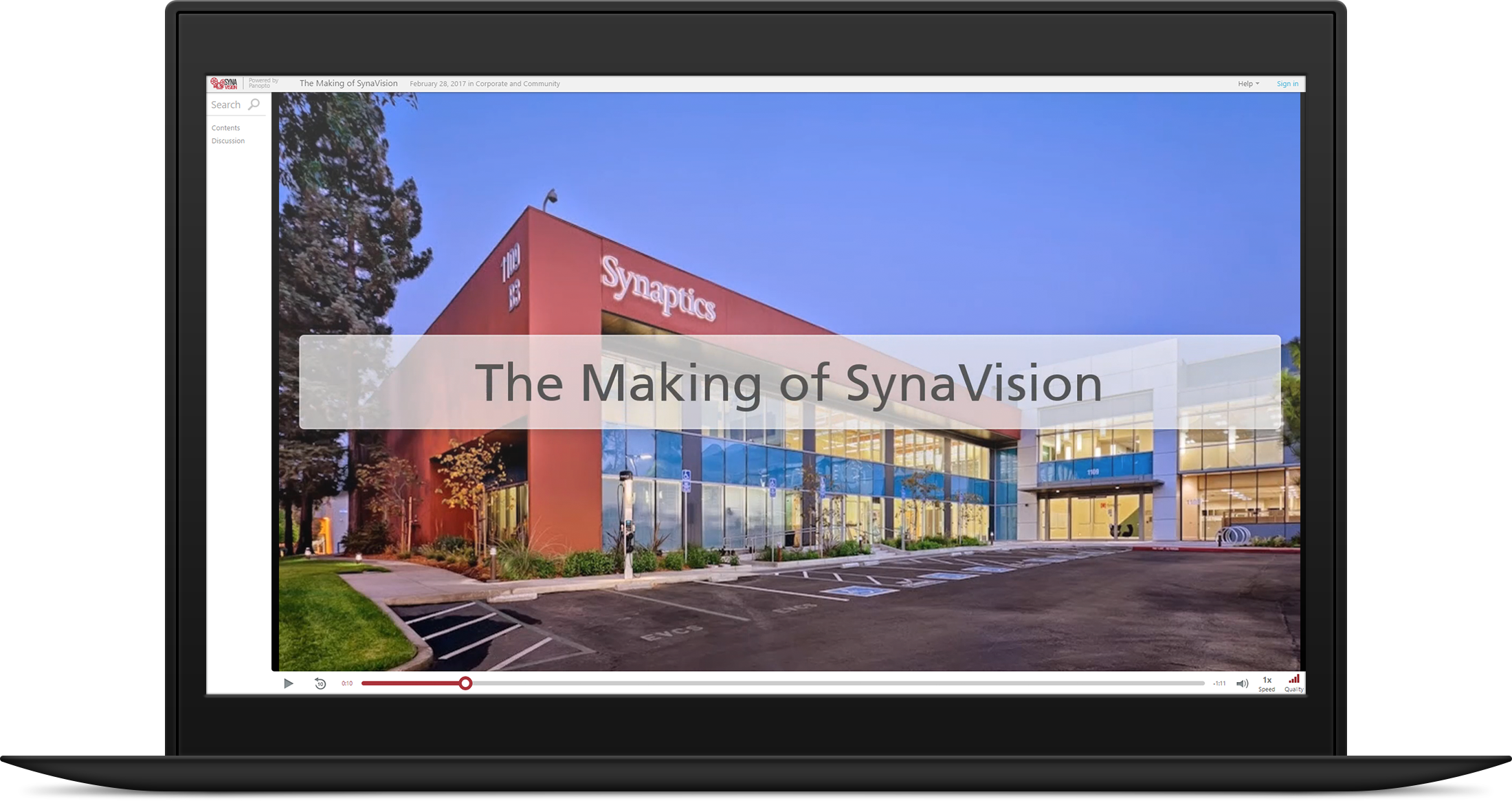- Communications
At Synaptics, Centralized Knowledge Sharing Supports Innovation And Saves 7,000 Working-Hours Annually
Few realize it, but most people interact with Synaptics “human interface” technologies every day. The company’s touch- and voice-enabling technologies are a key part of today’s smartphones, tablets, notebooks, automobiles, wearables, smart homes, and other applications. Synaptics helps users get the most out of their devices through an extensive portfolio of human-interface solutions that enable elegant, intuitive user experiences.
 The PC, smartphone, tablet and automotive-electronics markets that Synaptics serves are all constantly evolving and highly competitive. New or upgraded products are released at an incredibly fast pace, both by a wide range of competitors and by Synaptics itself.
The PC, smartphone, tablet and automotive-electronics markets that Synaptics serves are all constantly evolving and highly competitive. New or upgraded products are released at an incredibly fast pace, both by a wide range of competitors and by Synaptics itself.
To support and improve upon its market-leading technologies, Synaptics relies on its employees to fully understand both the company’s own suite of products as well as those they compete with. This expertise enables Synaptics employees to think beyond obvious solutions, adapt and apply answers from other functions or processes, and iterate on new ideas.
And when that expertise can be shared, it serves as the foundation for the culture of innovation upon which Synaptics’ products are built.
Missed insights and missed opportunities: Global growth underscores the need for centralized knowledge
For Synaptics, the advanced technical sophistication of its offerings created a straightforward challenge. Clear documentation of the company’s cutting-edge knowledge base was essential to ensure that every employee could understand, support, and improve upon the company’s products. At a practical level, however, such documentation was a challenge to keep up with. As product lines and market positions changed rapidly, often the most current details or most critical elements would be known only in the minds of the company’s subject matter experts.
Compounding issues, Synaptics as a company is organized into three distinct business units, each with its own internal structure. Members of any one team may not often interact with those of another. And if that weren’t enough, across each of those teams, more than half of Synaptics 2,300 employees are based in Asia, speaking English as their second language.
With no formal means of sharing knowledge internally, these structural, geographic, and language barriers sometimes made it difficult for an individual employee’s knowledge to be shared effectively with everyone else inside the company.
Creating more problems than it solves: Synaptics makes its first experiments with video for learning
Early on, Synaptics had begun experimenting with video as a means of sharing expertise.
“As a technology, video is one of the best ways to increase the velocity and accuracy of knowledge sharing,” said Minette Chan, Director of Learning Solutions at Synaptics. “When sharing complex and technical information, it often takes less time for an expert to record a quick explainer video than it would for them to document the same subject in writing.”
Yet while the choice of medium was easy, the question of how to implement a video-enabled knowledge sharing program loomed.
Video at Synaptics had generally been informal — employees stored their recordings on local networks and shared them via email. That made the video files useful to their creators, who could share them on-demand, but almost impossible for anyone else to find on their own.
More formal recordings, including videos of corporate events and internal training summits, were often produced by the Learning Solutions team. But there, a new challenge emerged: time. The video from a week-long training event might take weeks to finalize due to the time required for manual editing, tagging, and production. By the time the file could be available, many employees would have found the information presented there via some other means.
And no matter the source, there was one more challenge common to every video — searchability.
“When you’re seeking out a specific detail on a complex subject, it’s almost impossible to tell beforehand if a video will still be relevant, or if it will even have the exact information you need,” remarked one Synaptics employee. “I need specific information at a specific moment. I don’t have time to watch an hour-long video or dig through multiple documents to get what I need.”
Rethinking knowledge management: Make sharing expertise an integral part of creating expertise
Recognizing these challenges, Ms. Chan and the Learning Solutions department at Synaptics set an audacious goal.
Not only did they want to make formal and informal knowledge sharing more centrally accessible — they wanted to affect a change in Synaptics’ culture.
Instead of thinking about sharing institutional knowledge as a one off — something to be done only if another team member asked — Ms. Chan and team wanted every Synaptics employee to view video documentation of their expertise as a routine and valuable step in the process of creating that knowledge in the first place.
To achieve that goal, Ms. Chan and team set out to design and launch a program that would enable every member of the Synaptics team to preserve, present, and share formal and informal institutional knowledge — in a way that would not only be scalable, but also intuitive for a diverse set of professional users.
Seeing that the status quo wasn’t making video easy enough to achieve the team’s vision, Ms. Chan set out to find a more efficient means of supporting video for knowledge sharing.
When she looked at Panopto’s video platform, she saw a means to standardize every aspect of how Synaptics used video for sharing information, from creation and curation to storage, search, sharing, and streaming.

Click to see Synaptics’ video introduction to SynaVision
Introducing “SynaVision”: Synaptics launches its own corporate YouTube
With Panopto, Synaptics created its own internal video portal. Dubbed “SynaVision”, the platform made it easy for the Synaptics team to view, share, and also contribute videos to a secure and centralized library.
With SynaVision, employees could use Panopto to record virtually any activity where knowledge was shared — detailed walkthroughs delivered by subject matter experts, project kickoff and update meetings, procedural overviews, and more — anywhere, anytime, and using the webcams on the laptops and mobile devices they already had.
The technical aspects of video production and management were taken care of instantly, without the added time and cost of working with third party AV specialists. Through Panopto, every video file uploaded to SynaVision — whether new or old — would be automatically converted for optimal playback on any device, indexed for search, and made shareable so that other employees could watch on-demand. Teams and individuals just clicked “record,” presented the information they wanted to share, and let Panopto take care of the rest.
“SynaVision has helped us make information available sooner by reducing the time to publish,” said Ms. Chan. “What used to take two to four weeks now takes less than one business day. Using Panopto has made information sharing much more efficient and streamlined within our organization.”
For viewers, meanwhile, SynaVision could provide an active learning experience. Panopto’s in-video quizzing feature enabled video creators to include questions to reinforce key points in their videos. And Panopto’s variable-speed playback enabled viewers to speed up or slow down the video as it played — from half-speed to double-speed — a great assist to non-native language speakers.
Best of all, Panopto also made all the information shared in those video assets significantly easier to find by automatically indexing every word spoken or shown on-screen in each video. With a quick keyword search on SynaVision, Synaptics employees can now instantly fast forward to the exact moment in any video where the specific information they need is shared.
With SynaVision in place, Synaptics had established a complete, video-enabled solution for sharing expertise — one that would transcend team structures, language barriers, and geographic challenges, and give the company unprecedented access to its institutional knowledge.
Partnering for success: Synaptics and Panopto Support team up to ensure a successful launch
Prior to the introduction of SynaVision, Synaptics and Panopto worked together to develop a detailed rollout plan, including more than 40 elements to ensure a successful launch. Though employee adoption was the ultimate goal, basic awareness was the first target.
Months before its official unveiling, Synaptics and Panopto met to discuss ideas for ensuring SynaVision would be set up for success. Over several weeks, the combined team:
Over several months, the combined team:
- Held key stakeholder meetings to build excitement and solidify approvals
- Created simple demos of how to use Panopto and set up hands-on trials for key staff
- Identified internal ambassadors to be champions of the platform during rollout and trained each ambassador on basic tasks such as setting up folders, managing permission settings, and uploading video files
- Met with company IT specialists to proactively address any potential network and security issues that may have arisen with the global launch of a new video platform
- Met with key members of the legal team in order to set proactive policies and responses to ensure only appropriate materials would be shared
Critically, Ms. Chan and team also compiled and uploaded a significant amount of existing video content into its new library, ensuring visitors would have a wealth of options to watch and learn from right from day one. The team also recorded new content, intended to educate and excite Synaptics employees, and encourage their use of the platform.
“Every knowledge sharing initiative has its own ‘chicken-and-egg’ problem,” said Ms. Chan. “When it’s new, you want employees to get excited about it and visit the portal and see the value in it. But if there’s nothing much there the first time they visit, they won’t come back and contribute.”
Finally, on March 1st, the official launch date for the SynaVision portal, the team hosted an all-staff celebration to raise awareness, complete with cake and fun contests that enticed employees to give the new site a try.
Video sweeps Synaptics: Employees embrace SynaVision for sharing expertise
With SynaVision, Synaptics has amplified global employee knowledge sharing, providing a valued solution to the company’s challenge of making expertise accessible.
Shortly after the launch of the platform, more than 40 percent of company employees had visited SynaVision, watching thousands of hours of material.
Within just a few months, more than 1,000 videos could be found on SynaVision, and Synaptics employees from around the globe come to the site daily to seek out and consume information essential to their work.
Today the Learning Solutions department estimates that in any given week, SynaVision will save roughly a quarter of Synaptics employees approximately 15 minutes they’d otherwise spend searching for information. That modest individual gain translates to nearly 7,000 productive hours saved by the company annually, not to mention the increase in information sharing facilitated through SynaVision.
In short order, SynaVision won wide acclaim. In just its first year the platform was recognized as one of the year’s Best Advances in Learning Technology Implementation as part of the annual Brandon Hall Group Excellence in Learning Awards, and received The Innovation Award as part of Chief Learning Officer Magazine’s annual Learning in Practice Awards. In the month following rollout, Synaptics recognized Learning Solutions team for its innovative and intelligent video solution to complex, global knowledge-sharing challenges that directly impacted Synaptics’ bottom line.




